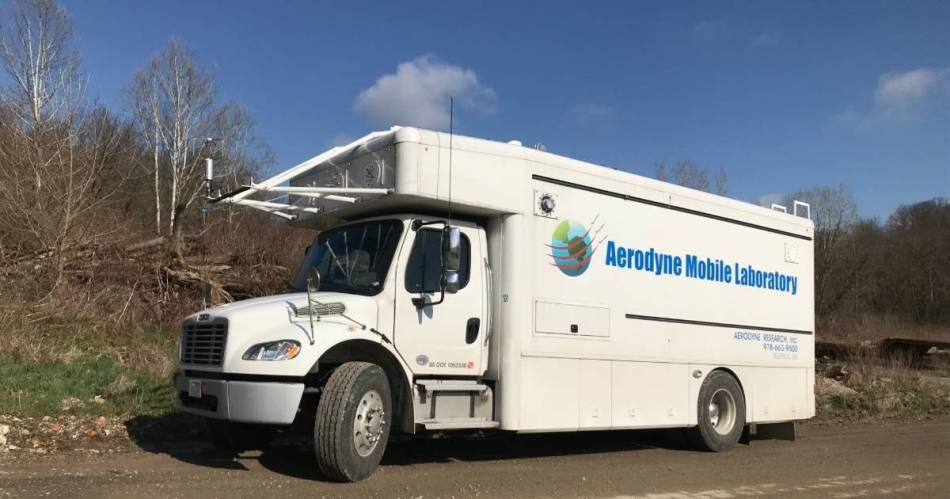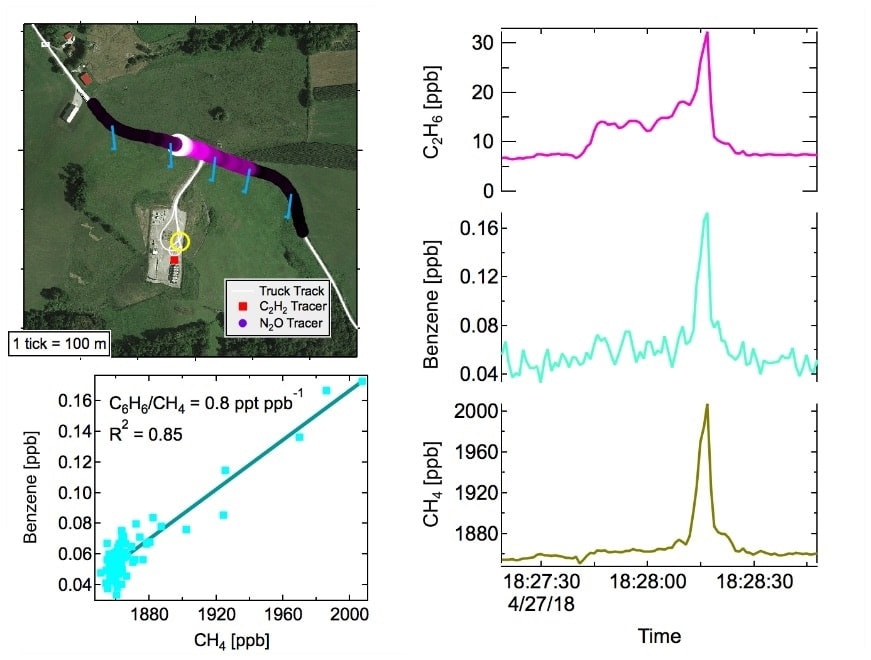
Natural gas production in North America has expanded drastically over the past several years, facilitated by horizontal drilling methods and hydraulic fracturing. The impacts of oil and gas well emissions on the environment are still a topic of extensive debate.
Mobile PTR-MS
To analyze the impacts of oil and gas well emissions, scientists from Aerodyne Research recently installed a Vocus 2R PTR-TOF to a U.S. production region. The Vocus PTR-TOF was set up on the Aerodyne Mobile Laboratory (AML) and designed to sample in conjunction with tunable infrared direct laser absorption spectrometers (TILDAS) measuring methane and ethane. Besides profiling the VOC emissions, spatially resolved PTR-MS measurements can help identify particular sources of methane, which can be hard to trace directly due to its higher background levels and a huge number of sources.
Concentrations of the VOCs quickly decline as plumes move from the wells, so correct mapping of the VOCs necessitates a detector with ultra-low limits of detection, such as the Vocus PTR-TOF.
Tracer Release Method
In partnership with the well-established company, the Aerodyne team installed dual tracer release points on the well pad. Dual tracer flux ratio measurements enable quantification of chemicals leaking or released from a well by comparison to known quantities of chemicals discharged from a tracer release device. [Allen et al., 2013; Lamb et al., 1995; Mitchell et al., 2015; Roscioli et al., 2017; Roscioli et al., 2015; Yacovitch et al., 2017].
The tracer release device consists of a tank of a harmless, volatile gas to be discharged in a controlled and known quantity; a mass flow controller to exactly measure the quantity of discharged gas; and a GPS device that exactly recorded the coordinates of the release point. By driving the AML to trail the tracer release gas downwind from the well and constantly measuring how much was dissipated and diluted, the Aerodyne team could compute the concentration of gases being released from various equipment on the well pad.
Vocus PTR-TOF measurements of oil and gas well emissions were made from the AML, while driving at speeds of less than 50 km/hour. Data were saved at 1 spectrum/second, matching to a spatial resolution of 14 m or more. The Vocus PTR-TOF drew five standard liters per minute (SLPM) of air from an inlet located on the front of the AML via a 2 m-long Teflon line. Tofware analysis software was used to process the data.
At distances of 0.5 to 2 km downwind of the well, the Vocus PTR-TOF could detect improvements of benzene, toluene, xylene, and other VOCs in the 10-100’s of ppt.
Oil and Gas Well Emissions Results
Figure 1 illustrates the result of a specific emission plume encounter at an example oil and gas production pad. The plume displayed molar emission ratios of benzene to methane and ethane at 0.8 and 3.8 ppt ppb-1, respectively.

Figure 1. Benzene plume detection at oil and gas production site. The upper left panel indicates the ground track of the Aerodyne Mobile Laboratory colored and sized by the 1-s ethane mixing ratio. The right panel depicts the time series for this plume encounter.
References
US Energy Information Administration: Drilling Productivity Report, available at: http://www.eia.gov/petroleum/drilling/, last accessed: 1 December 2018
Allen, D. T., et al. (2013), Measurements of methane emissions at natural gas production sites in the United States, Proc. Natl. Acad. Sci. U. S. A., 110(44), 17768-17773, doi:10.1073/pnas.1304880110.
Lamb, B. K., et al. (1995), Development of Atmospheric Tracer Methods to Measure Methane Emissions from Natural-Gas Facilities and Urban Areas, Environ. Sci. Technol., 29(6), 1468-1479, doi:10.1021/es00006a007.
Mitchell, A. L., et al. (2015), Measurements of Methane Emissions from Natural Gas Gathering Facilities and Processing Plants: Measurement Results, Environ. Sci. Technol., 49(5), 3219-3227, doi:10.1021/es5052809.
Roscioli, J. R., S. C. Herndon, T. I. Yacovitch, W. B. Knighton, D. Zavala-Araiza, M. R. Johnson, and D. R. Tyner (2017), Characterization of Methane Emissions from Cold Heavy Oil Production with Sands (CHOPS) Facilities, J. Air Waste Manage. Assoc., submitted.
Roscioli, J. R., et al. (2015), Measurements of methane emissions from natural gas gathering facilities and processing plants: measurement methods, Atmos. Meas. Tech., 8(5), 2017-2035, doi:10.5194/amt-8-2017-2015.
Yacovitch, T. I., C. Daube, T. L. Vaughn, C. S. Bell, J. R. Roscioli, W. B. Knighton, D. D. Nelson, D. Zimmerle, G. Pétron, and S. C. Herndon (2017), Natural gas facility methane emissions: measurements by tracer flux ratio in two US natural gas producing basins, Elem. Sci. Anth., 5, 69, doi:10.1525/elementa.251.

This information has been sourced, reviewed and adapted from materials provided by TOFWERK.
For more information on this source, please visit TOFWERK.